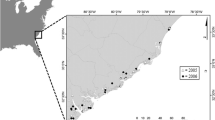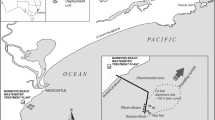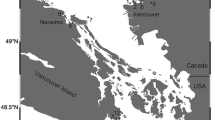Abstract
In situ and laboratory bioassays using the eastern oyster, Crassostrea virginica, were undertaken in the Wright River Estuary, South Carolina, to determine the toxic potential of effluent and sediment from recently dredged sediments. Current standards (ASTM, USEPA, and USACE) rely solely on laboratory-based bioassays to assess toxicity of dredge spoils prior to disposal. These bioassays do not necessarily replicate the natural physicochemical estuarine processes, limiting the environmental realism of this approach. In this study, oysters were collected from a site on Leadenwah Creek (SC) and deployed in plastic cages anchored above the sediment and within the intertidal zone for 90 days at four dredge spoil disposal areas (18 sites total, one bushel/site). Oysters were also deployed at a reference site (New River Estuary, SC) and the original collection site. Trace metals and polycyclic aromatic hydrocarbons (PAHs) in tissue, sediment, and effluent samples as well as the assessment of oyster health in adults (% mortality and % reduction in potential yield) and larvae (larval development) were measured. Results indicated high arsenic concentrations in surface water samples (<10 to 147 μg/L), some of which exceeded the USEPA chronic marine water quality criteria and sediment concentrations (<1.0–82.2 mg/kg), which also exceeded the ERM (70 mg/kg) and the ERL (8.2 mg/kg) for arsenic, and which may have contributed to the toxic response seen in deployed oysters. A positive relationship was also seen between the in situ percent reduction in potential yield and laboratory-derived data from larval oyster development bioassays. The advantage of the combined in situ/laboratory approach used in this study is the ability to resolve probable factors influencing the toxicity of these effluents to oysters.
Similar content being viewed by others
References
ASTM (1988) Standard practice for conducting static acute toxicity tests with larvae of four species of bivalve mollusc. ASTM E 724–80. American Society for Testing and Materials, Philadelphia, PA, pp 256–271
Aston SR, Thornton I, Webb JS, Milford BL, Purves JB (1975) Arsenic in stream sediments and waters of southwest England. Science Total Environ 4:347–358
Butler PA (1953) Oyster growth as affected by latitudinal temperature gradients. U.S. Bureau of Commercial Fisheries, U.S. Fish and Wildlife Service, Commercial Fisheries Review, Vol. 15(6):7–11
Crecelius EA, Bothner MH, Carpenter R (1975) Geochemistrys of arsenic, antimony, mercury, and related elements in sediments of Puget Sound. Environ Sci Technol 9:325–333
Davis HC (1958) Survival and growth of clam and oyster larvae at different salinities. Biolog Bull 114:296–307
Davis HC, Calabreese A (1964) Combined effects of temperature and salinity on the development of eggs and larvae of M. mercenaria and C. virginica. Fisheries Bulletin of the Untied State Fish and Wildlife Service, Volume 63, 634 pp
Fulton MH, Scott GI, Fortner AR, Bidleman TF, Ngabe B (1993) The effects of urbanization on small, high salinity estuaries of the southeastern United States. Arch Environ Contam Toxicol 25:476–484
Galtsoff PS (1964) The American oyster Crassostrea virginica Gemlin. Fishery Bulletin of the United States Fish and Wildlife Service, Volume 64, 480 pp
Klumpp DW, Peterson PJ (1979) Arsenic and other trace elements in the waters and organisms of an estuary in southwest England. Environ Pollut 19:11–20
LaSalle MW, Clarke DG, Homziak J, Lunz JD, Fredette TJ (1991) A framework for assessing the need for seasonal restrictions in dredging and disposal operations. U.S. Department of the Army, Army Corps of Engineers, Washington DC, Technical Report D-91–1:42–47
Long ER, MacDonald DD, Smith SL, Calder FD (1995) Incidence of adverse biological effects within ranges of chemical concentrations in marine and estuarine sediments. Environ Manag 19:81–97
MacDonald DD (1993) Development of an approach to the assessment of sediment quality in Florida coastal waters. Prepared for Florida Dept of Environmental Regulation, 133 pp
Marcus JM, Scott GI (1990) The integration of sediment trace metal bioavailability and land-use practice as a method of environmental risk assessment. Amer Soc for Test Mat E-47, 13th Symposium on Aquatic Toxicology and Hazard Evaluation, Atlanta, GA, ASTM STP 1096:247–263
Martin M, Osborn KE, Billig P, Glickstein N (1981) Toxicities of ten metals to Crassostrea gigas and Mytilus edulis embryos and Cancer magister larvae. Marine Pollut Bull 12:305–308
McLusky DS, Bryant V, Cambell R (1986) The effects of temperature and salinity on the toxicity of heavy metals to marine and estuarine invertebrates. Oceanogr Mar Biol Ann Rev 24:481–520
Moore JW, Ramamoorthy S (1984) Heavy metals in natural waters: Applied monitoring and impact assessment. Springer-Verlag, NY, pp 4–27
Richardson CW, Price JD, Burnett E (1978) Arsenic concentrations in surface runoff from small watersheds in Texas. J Environ Qual 7:189–192
Ringwood AH (1992) Comparative sensitivity of gametes and early developmental stages of a sea urchin species (Echinometra mathaei) and a bivalve species (Isognomon californicum) during metal exposures. Arch Environ Contam Toxicol 22:288–295
Sadiq M (1992) Toxic metal chemistry in marine environments. Marcel Dekker, NY, Environ Sci Pollut Control Series: 106–153
Scott GI (1979) The effects of seasonal chronic chlorination on the growth, survival, and physiology of the American oyster, Crassostrea virginica (Gemlin). PhD Dissertation. University of South Carolina
Scott GI, Sammons TI, Middaugh DP, Vernberg WB (1984) Interactions of the protistan, Perkinsus marinus, and chlorine-produced oxidants, salinity, and temperature in affecting lethal and sublethal effects in the American oyster, Crassostrea virginica. In: Vernberg WB, Calabreese A, Thurberg FP, Vernberg FJ (eds) Pollution and physiology of marine organisms. Academic Press, NY. pp 351–376
Strozier S (1995) The effects of urbanization on the American oyster, Crassostrea virginica: Bacteriological and oyster disease interactions. PhD dissertation (in preparation)
U.S. Army Corps of Engineers (1994) Ecotoxicological assessment of effluent and sediments from the Savannah Harbor dredged material disposal areas in the Wright River estuary of South Carolina. Final Report, 245 p, Prepared for the U. S. Army Corps of Engineers, Savannah District, Savannah, GA
U.S. Environmental Protection Agency (1983) Methods for chemical analysis of water and waste. Revised March 1983. EPA 600/4-79-020
— (1986) Quality criteria for water 1986. Office of Water. EPA 440/5-85-001
— (1989) Assessing human health risks from chemically contaminated fish and shellfish. Office of Marine and Estuarine Protection and Office of Water Regulations and Standards. Washington, DC. EPA-503/8–89–002
— (1992a) Sediment classification methods compendium. Office of Water. Washington, DC. EPA-823-R-92–006
— (1992b) Test methods for evaluating solid waste: Physical/chemical methods. Third edition. EPA 530/SW846
— (1994) Methods for the determination of metals in environmental samples, supplement I to EPA 600/4-91-010. EPA 600/R-94-111
U.S. Environmental Protection Agency and U.S. Army Corps of Engineers (1991) Evaluation of dredged material proposed for ocean disposal (“Green Book”). EPA -503/8-91/001
Van der Veen C, Huizenga J (1980) Combating river pollution taking the Rhine as an example. Progress water technology 12:1035–1059
Vernberg FJ, Vernberg WB (1972) Environmental physiology of marine animals. Springer-Verlag, NY, 346 pp
Waslenchuk DG (1979) The geochemical controls on arsenic concentrations in southeastern United States rivers. Chem Geol 24:315–325
Author information
Authors and Affiliations
Rights and permissions
About this article
Cite this article
Wirth, E.F., Scott, G.I., Fulton, M.H. et al. In situ monitoring of dredged material spoil sites using the oyster Crassostrea virginica . Arch. Environ. Contam. Toxicol. 30, 340–348 (1996). https://doi.org/10.1007/BF00212292
Received:
Revised:
Issue Date:
DOI: https://doi.org/10.1007/BF00212292




